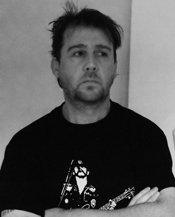Tony South (Born 1964)

The mid-sized city of Rotherham in South Yorkshire, England has been home to Tony South for most of his life. Although the community’s roots date to the early medieval period, South grew up during the years when the booming steel industry and coal mines began to dwindle. Born in 1964, he attended local schools where his predilection for drawing was evident at an early age.
His favorite artist--and primary inspiration in those years--was Stanley Martin Lieber (b. 1922), better known to Marvel Comics aficionados as Stan Lee. As the creator and co-creator of Spider Man, the Hulk, the Fantastic Four, X-men, Thor and many others, Lee helped to transform action heroes from two-dimensional “good guys” into more visually compelling human figures whose personal problems often informed their actions. For a young artist like South, Lee’s imagery provided a starting point for learning not only how to draw, but also how to construct a narrative through images.
That early emulation of Stan Lee’s work has proven to have lasting value. As South notes somewhat ironically, his work was once compared to Norman Rockwell’s illustrations, an unlikely parallel in terms of subject matter; nonetheless, the ability to suggest a story through the juxtaposition of carefully defined images clearly links South to the longstanding tradition of narrative painting--whether Stan Lee or Norman Rockwell.
In secondary school, South was expected to take both art and music classes as part of his general education, and it was at this point that music became his central interest. He had learned to play percussion as part of the wind orchestra in school, and then continued to play in a variety of bands independently. After graduation, he worked briefly as a bricklayer, but gladly accepted an offer to be the drummer with a professional band in 1984. The next fifteen years were spent working in clubs throughout the United Kingdom, plus the odd gig in Europe, making his living as a musician. South lives with his long-term partner, Joanne, a social worker from Sheffield, and their young daughter Maisie.
By 1997, the life of a working musician, with its routine exposure to alcohol consumption, caught up with South, and he realized that he needed to stop drinking. That meant entering a rehabilitation program and recognizing that part of the recovery process was distancing himself from an environment where alcohol consumption was expected. Drawing and painting became part of his path to sobriety. As he remarks, “You have a lot of spare time when you’re not drinking” and painting allowed him to express his emotions as he went through recovery. He began with watercolors, and eventually moved to oil painting, always with a sense of urgency about “painting what comes into my head.”
As South emerged from the initial stages of rehabilitation, he began to consider a career as a painter. When a friend asked him to paint his modified car, he was delighted. That led to his move into a career in motorsport art, which provided South with a strong technical education in painting. Five years later, in 2005, he was ready to shift into being a full-time artist, leaving behind the limited parameters of advertising slogan painting for the world of galleries and exhibitions of his own work. To that end, he successfully sought out galleries in London that might be interested in his work, and ultimately, began to exhibit at the Rebecca Hossack Gallery there.
Over the years South has increasingly worked with thin glazes of oil paint on top of a white acrylic underpainting. The smooth surface of the acrylic paint allows him to layer transparent oil glazes until he achieves the vibrant but nuanced variations in color that best reflects the image he wants. The striking contrast between the crisp white background and the subtly colored central forms offers viewers an opportunity to explore not only the immediate impact of the image itself, but also the extraordinary depth of the painted surface.
South’s intensity about his work remains undiminished. “I have to keep pushing ideas forward before I forget them,” he says, noting that “I have to follow what pops into my head.”
Janet Whitmore, Ph.D.